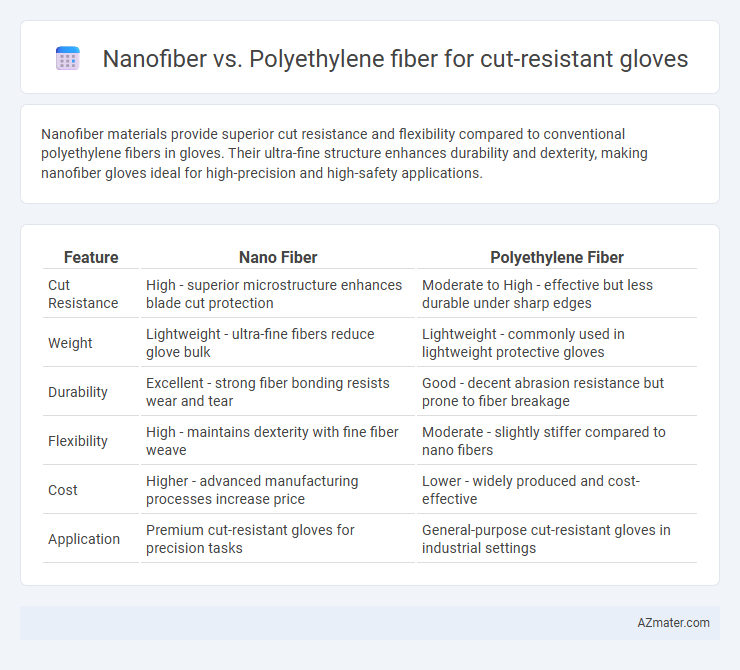Nanofiber materials provide superior cut resistance and flexibility compared to conventional polyethylene fibers in gloves. Their ultra-fine structure enhances durability and dexterity, making nanofiber gloves ideal for high-precision and high-safety applications.
Table of Comparison
| Feature | Nano Fiber | Polyethylene Fiber |
|---|---|---|
| Cut Resistance | High - superior microstructure enhances blade cut protection | Moderate to High - effective but less durable under sharp edges |
| Weight | Lightweight - ultra-fine fibers reduce glove bulk | Lightweight - commonly used in lightweight protective gloves |
| Durability | Excellent - strong fiber bonding resists wear and tear | Good - decent abrasion resistance but prone to fiber breakage |
| Flexibility | High - maintains dexterity with fine fiber weave | Moderate - slightly stiffer compared to nano fibers |
| Cost | Higher - advanced manufacturing processes increase price | Lower - widely produced and cost-effective |
| Application | Premium cut-resistant gloves for precision tasks | General-purpose cut-resistant gloves in industrial settings |
Introduction to Cut-Resistant Glove Materials
Nano fibers and polyethylene fibers serve as pivotal materials in cut-resistant gloves, each exhibiting unique protective properties. Nano fibers, defined by their ultra-fine diameters, create dense, interlocking structures that significantly enhance cut resistance and dexterity. Polyethylene fibers, especially ultra-high-molecular-weight polyethylene (UHMWPE), offer exceptional tensile strength and lightweight durability, making them a popular choice for industrial gloves requiring superior cut protection.
Overview of Nano Fiber Technology
Nano fiber technology enhances cut-resistant gloves by providing ultra-fine fibers with a high surface area-to-volume ratio, resulting in superior strength and flexibility compared to traditional polyethylene fibers. These nano fibers offer improved cut resistance and durability through advanced materials like electrospun polymers that create tightly woven, lightweight protective layers. The integration of nano fibers in glove manufacturing enables better dexterity and comfort while maintaining high performance in industrial safety applications.
Overview of Polyethylene Fiber (HPPE)
Polyethylene fiber, specifically High-Performance Polyethylene (HPPE), is widely used in cut-resistant gloves due to its exceptional strength-to-weight ratio and high tensile strength. HPPE fibers offer excellent cut resistance, lightweight comfort, and chemical resistance, making them ideal for industrial safety applications. Their low moisture absorption and resistance to abrasion enhance glove durability and performance in demanding environments.
Mechanical Strength Comparison
Nano fibers exhibit superior mechanical strength compared to polyethylene fibers in cut-resistant gloves, offering enhanced tensile strength and resistance to abrasion. The high surface area-to-volume ratio of nano fibers contributes to improved load distribution and durability under mechanical stress. Consequently, gloves reinforced with nano fibers provide greater cut resistance and longer service life than those utilizing traditional polyethylene fibers.
Cut Resistance Performance
Nano fiber offers superior cut resistance compared to polyethylene fiber due to its finer diameter and higher tensile strength, which create a denser and more robust protective barrier. Polyethylene fibers, while lightweight and durable, typically exhibit lower cut resistance levels and may require additional layering to achieve similar protection. The enhanced molecular structure of nano fibers effectively resists blade penetration, making them a preferred choice in high-performance cut-resistant gloves.
Comfort and Flexibility
Nanofiber cut-resistant gloves offer superior comfort and flexibility due to their ultra-fine fiber diameter, allowing for a lightweight and breathable fabric structure that closely conforms to hand movements. Polyethylene fiber gloves, while highly durable and resistant to cuts, tend to be stiffer and less breathable, which can compromise comfort during extended wear. The nanofiber's enhanced flexibility and softness significantly improve dexterity and reduce hand fatigue compared to the more rigid polyethylene fiber gloves.
Durability and Longevity
Nano fibers used in cut-resistant gloves exhibit superior durability due to their high tensile strength and resistance to abrasion, significantly enhancing glove longevity compared to traditional polyethylene fibers. Polyethylene fibers, while lightweight and offering good cut resistance, generally wear down faster under continuous use and harsh conditions, reducing the overall lifespan of the glove. The advanced structural properties of nano fibers enable them to maintain cut resistance performance over extended periods, making them ideal for demanding industrial applications.
Breathability and Moisture Management
Nanofiber materials in cut-resistant gloves offer superior breathability due to their ultra-fine fiber diameter, allowing enhanced air circulation and moisture vapor transmission. Polyethylene fibers provide excellent cut resistance but tend to be less breathable, often trapping heat and moisture inside the glove. Effective moisture management in nanofiber gloves reduces sweat accumulation and improves comfort during prolonged use, making them preferable for tasks requiring both protection and wearability.
Cost and Availability
Nanofiber gloves typically offer superior cut resistance but come at a higher cost due to advanced manufacturing processes and limited production scale. Polyethylene fiber gloves, such as those made from ultra-high-molecular-weight polyethylene (UHMWPE), provide a cost-effective alternative with widespread availability and ample supply for large-scale industrial use. The choice between nanofiber and polyethylene fibers often hinges on balancing budget constraints with the required performance level for specific safety applications.
Conclusion: Choosing the Right Fiber for Cut-Resistant Gloves
Nano fiber offers superior cut resistance due to its high tensile strength and ultra-fine structure, providing enhanced protection for critical applications. Polyethylene fiber, known for its lightweight nature and durability, delivers excellent cut resistance but may lack the flexibility and comfort of nano fibers. Selecting the right fiber depends on the balance between protection level, glove flexibility, and specific use-case requirements in industrial safety.

Infographic: Nano fiber vs Polyethylene fiber for Cut-resistant glove
 azmater.com
azmater.com